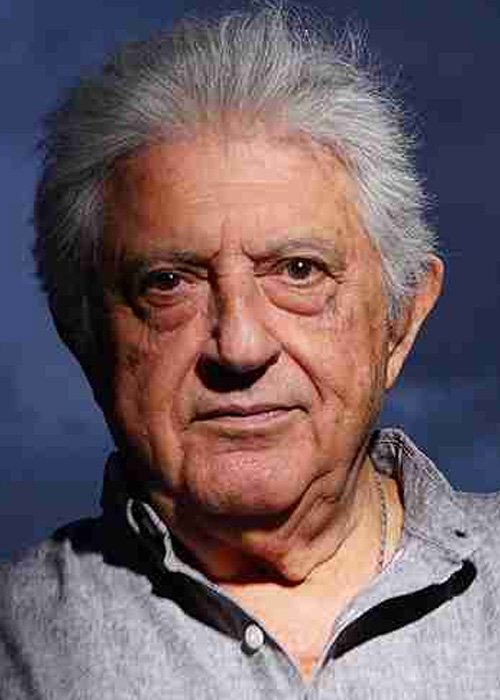
Manuel Pérez Clemente (better known as Sanjulián; born 24 June 1941) is a Spanish painter, most notable for his comics, magazine, and novel covers. He was born in Barcelona, and studied at Belles Arts of Sant Jordi.
Sanjulián began working for Selecciones Ilustradas circa 1962, and Warren Publishing in 1970.
He has had multiple shows at The Society of Illustrators in New York City, and was a guest at the 2008 Emerald City ComiCon.
From pulp magazines to classic fantasy novels, few artists have conjured more iconic imagery than Manuel Sanjulián. Born in Barcelona in 1941, Sanjulián studied at the prestigious Sant Jordi Academy of Fine Arts before joining the renowned Spanish art agency Selecciones Ilustradas in the early 1960s. What began as a career in comic storytelling quickly shifted toward full-color illustration, where his talents would flourish on an international stage.
His early works were seen across Europe and Scandinavia, but it was the British publishing scene that first embraced his signature blend of realism and fantasy. Publishers like Futura and Fontana welcomed his powerful brushstrokes, but it was America that made him a legend. In the 1970s, Sanjulián’s breathtaking covers for Vampirella, Creepy, and Eerie—published by Warren Publishing—cemented his legacy among the greatest fantasy artists of all time.
His art wasn’t just technically brilliant—it pulsed with life. Warriors, vampires, monsters, and mystics seemed to leap from his canvases. Each cover told a story in a single image, a talent he honed as he transitioned from comics to fully painted illustrations. Known for using oil on canvas, Sanjulián’s paintings recall the precision of Velázquez and the mood of classic cinema. Fans often compared him to Frank Frazetta—an artist Sanjulián admired—but with a more photographic realism.
Throughout his career, he produced covers for publishers such as Dell, Ace, DAW, Bantam, Fawcett, and Berkeley. He also worked on special projects, including film posters, book series like Conan and The Empire Strikes Back, and collaborations with horror icons like Clive Barker. His versatility allowed him to shift effortlessly between genres: horror, sci-fi, fantasy, and historical epics.
Today, Sanjulián’s work can be found in private collections, museums, and galleries worldwide. He has been honored by the Society of Illustrators and remains represented by Corner4Art, an exclusive European dealer. In a world filled with digital noise, Sanjulián’s mastery of traditional media reminds us of the raw power of paint and passion.
Behind every fierce warrior and haunting vampire he painted, Manuel Pérez Clemente—known to the world as Sanjulián—lived a life guided by discipline, humility, and a love for classical beauty. Born in Barcelona in 1941, Sanjulián didn’t initially plan to be an artist. As a teenager, he enrolled in nautical school with dreams of becoming a merchant marine, following family tradition. Art, at that point, was just a hobby.
But destiny had other plans. To earn some money, he began creating portraits of movie stars and offered them to film distributors as poster designs. After a small opportunity with Fox in 1959, he took the advice of a family friend and entered art school. At 20, he joined the Sant Jordi Academy of Fine Arts, where he studied until 25 and met the peers who would steer him into illustration.
Early jobs were challenging—romantic comics for Editorial Bruguera, historical stories at Selecciones Ilustradas—all under tight deadlines and without credit. Still, he pushed forward. A turning point came when his early painted covers were rejected by agency head Josep Toutain. Offended, Sanjulián created three more and returned. Toutain’s response? “I’ll buy them all.” From then on, he was a cover artist.
Sanjulián married, raised two children, and settled in Sitges, a coastal town whose rich cultural atmosphere became his sanctuary. He worked long hours but lived simply. He painted with a brush “of a single hair,” his peers joked—an obsessive attention to detail that made his work unforgettable.
In his free time, he enjoyed classical art, film, and walking along the sea. Despite international acclaim, he remained private and humble, resisting the distinction between “illustration” and “fine art.” For him, art was art. Whether for a book, a gallery, or a film festival poster, each work was done with the same reverence.
Today, at home in Sitges, surrounded by his paints, brushes, and the memories of a lifetime in color, Sanjulián continues to inspire. His legacy is not only what he painted—but how he lived: quietly, intensely, and always true to himself.